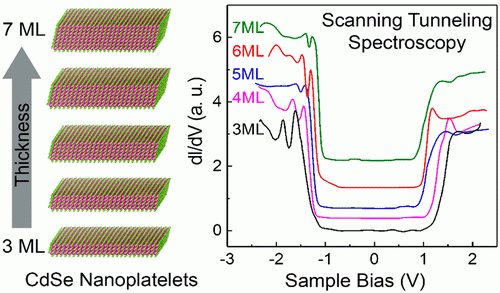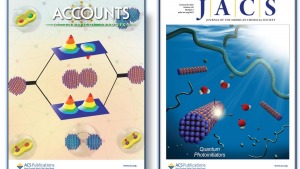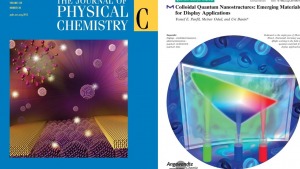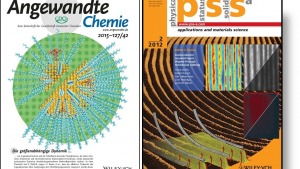Citation:
Abstract:
"Quasi-two-dimensional (2D) Semiconductor Nanoplatelets manifest strong quantum confinement with exceptional optical characteristics of narrow photoluminescence peaks with energies tunable by thickness with monolayer precision. We employed scanning tunneling spectroscopy (STS) in conjunction with optical measurements to probe the thickness-dependent band gap and density of excited states in a series of CdSe nanoplatelets. The tunneling spectra, measured in the double-barrier tunnel junction configuration, reveal the effect of quantum confinement on the band gap taking place mainly through a blue-shift of the conduction band edge, along with a signature of 2D electronic structure intermixed with finite lateral-size and/or defects effects. The STS fundamental band gaps are larger than the optical gaps as expected from the contributions of exciton binding in the absorption, as confirmed by theoretical calculations. The calculations also point to strong valence band mixing between the light- and split-off hole levels. Strikingly, the energy difference between the heavy-hole and light-hole levels in the tunneling spectra are significantly larger than the corresponding values extracted from the absorption spectra. Possible explanations for this, including an interplay of nanoplatelet charging, dielectric confinement, and difference in exciton binding energy for light and heavy holes, are analyzed and discussed."
The tunneling spectra, measured in the double-barrier tunnel junction configuration, reveal the effect of quantum confinement on the band gap taking place mainly through a blue-shift of the conduction band edge, along with a signature of 2D electronic structure intermixed with finite lateral-size and/or defects effects. The STS fundamental band gaps are larger than the optical gaps as expected from the contributions of exciton binding in the absorption, as confirmed by theoretical calculations. The calculations also point to strong valence band mixing between the light- and split-off hole levels. Strikingly, the energy difference between the heavy-hole and light-hole levels in the tunneling spectra are significantly larger than the corresponding values extracted from the absorption spectra. Possible explanations for this, including an interplay of nanoplatelet charging, dielectric confinement, and difference in exciton binding energy for light and heavy holes, are analyzed and discussed."





